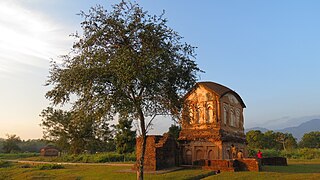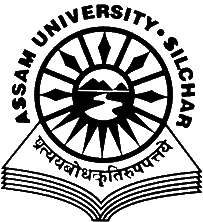The Hmar language or Khawsak ṭawng belongs to the Kukish branch of the Sino-Tibetan family of languages. The speakers of the language are also known as Hmar.

Cachardistrict is an administrative district in the state of Assam in India. After independence, the undivided Cachar district was split into four districts in Assam: Dima Hasao district, and Cachar district alongside Hailakandi and Karimganj.

Hailakandi district is one of the 33 districts of Assam state in north-eastern India. It makes up the Barak Valley alongside Cachar and Karimganj. It was constituted as a civil subdivision on 1 June 1869. Subsequently, it was upgraded to a district in 1989, when it was split from Cachar district.

Karimganj district is one of the 34 districts of the Indian state of Assam. Karimganj town is both the administrative headquarters district and the biggest town of this district. It is located in southern Assam and borders Tripura and the Sylhet Division of Bangladesh. It makes up the Barak Valley alongside Hailakandi and Cachar. Karimganj was previously part of the Sylhet District before the Partition of India. It became a district in 1983.

Dima Hasao district, is an administrative district in the state of Assam, India. As of 2011, it is the least populous district of Assam.

Silchar is a city and the headquarters of the Cachar district of the state of Assam, India. It is 2nd largest city of North Eastern Region after Guwahati in terms of area, population and GDP. It is also administrative capital of Barak Valley division. It is located 343 kilometres south east of Guwahati. It was founded by Captain Thomas Fisher in 1832 when he shifted the headquarters of Cachar to Janiganj in Silchar. It earned the moniker "Island of Peace" from Indira Gandhi, the then Prime Minister of India. Silchar is the site of the world's first polo club and the first competitive polo match. In 1985, an Air India flight from Kolkata to Silchar became the world's first all-women crew flight. Silchar was a tea town and Cachar club was the meeting point for tea planters.

The Dimasa people are an ethnolinguistic community presently inhabiting in Assam and Nagaland states in Northeastern India. They speak Dimasa, a Tibeto-Burman language. This community is fairly homogeneous and exclusive, with members required to draw from both parents' separate clans. Dimasa kingdom, one of many early states in Assam following the downfall of Kamarupa kingdom, was established by these people. The Dimasas were till recently agricultural, centering on shifting agriculture; but in recent times this has changed with profound changes in the community. Following political problems in the 18th century, the Dimasa ruler moved further south in the plains of Cachar and there took place a division among them–with the hills Dimasa maintaining their traditional living and political exclusiveness, the plains Dimasas have made no attempt to assert themselves.
The Dimasa language is a Sino-Tibetan language spoken by the Dimasa people of the Northeastern Indian states of Assam and Nagaland. The Dimasa language is known to Dimasas as "Grao-Dima" and it is similar to Boro, Kokborok and Garo languages.
Maibang is a town and a town area committee in Dima Hasao district in the Indian state of Assam. Maibang is also one of the three sub-divisions of Dima Hasao District. It was once the capital of the Dimasa Kachari Kingdom. There is a stone house of Dimasa king.

The Barak Valley is in the southern region of the Indian state of Assam. The region is named after the Barak river. The Barak valley consists of three administrative districts of Assam - namely Cachar, Karimganj, and Hailakandi. The main, largest and capital city of the Valley is Silchar. Once North Cachar Hills was a part of the valley but In 1951 erstwhile Sub-Division was made a separate district and eventually curved out of Cachar. On 1 July 1983, Karimganj district was curved out from the eponymous subdivision of Cachar Valley. This was again repeated in 1989 with the creation of Hailakandi district.

Assam University is a collegiate central public university located at Silchar, Assam, India. It was founded in the year 1994 by the provisions of an act enacted by the Parliament of India. The Governor of Assam is the Chief Rector and the President of India is acting as the Visitor of the university. The Chancellor is the ceremonial head of the university while the executive powers rest with the Vice-chancellor. The university has sixteen schools which offer Humanities, Languages, Environmental Sciences, Information Sciences, Life Sciences, Physical Sciences, Social Sciences, Law, Technology and Management Studies. There are 42 departments under these sixteen schools. The five districts under the jurisdiction of Assam University have 73 undergraduate colleges as on 31 March 2020. Assam University is an institutional signatory to the Global Universities Network for Innovation (GUNI), Barcelona and United Nations Global Compact (UNGC) for its commitment to educational social responsibilities.

The Bengali Language Movement of Barak Valley was a protest against the decision of the Government of Assam to make Assamese the only sole official language of the state, even though knowing that a major proportion of the Barak Valley population speaks Bangla language. About 80% of the Valley's residents are ethnic Bengalis. In the Barak Valley region, the ethnic Bengali population consists of both Hindus and Muslims, who are almost equal in population and constitute the overwhelming majority of the population. There is also a substantial minority of native tribals and immigrants from other parts of India. The main incident took place on 19 May 1961 at Silchar railway station in which 11 ethnic Bengalis were killed by Assam police.
The Regions of Assam are non-administrative units in the Indian state of Assam with a common historical past. Not all these regions are mutually exclusive.

The Undivided Cachar district is a former administrative district of Assam Province that is largely congruous to Govinda Chandra's, the last king of the Kachari kingdom, domain in the southern part of Assam. It has been divided into the present-day Cachar, Dima Hasao and Hailakandi districts in recent times. Dima Hasao is an Autonomous hill district of Assam, remaining Cachar and Hailakhandi of Dimasa Kingdom are a part of Barak Valley region. While Karimganj was a part of Sylhet, before Partition of Bengal.
The Barman Kacharis are an indigenous community of Northeast India and are a subsection of the Dimasa people in Barak Valley but claim to a separate group in Brahmaputra Valley. They are mainly found in the districts of Lower Assam and in Barak Valley like Cachar, Hailakandi and Karimganj and some parts of Arunachal Pradesh. Barman Kachari is Dimasa convert group of North-East India. Since the 2002 Amendment act, many Barman Kacharis in Assam are referred to as 'Barman'. They are sparsely found in Brahmaputra valley.
Assam – 16th largest, 15th most populous and 26th most literate state of the 28 states of the democratic Republic of India. Assam is at 14th position in life expectancy and 8th in female-to-male sex ratio. Assam is the 21st most media exposed states in India. The Economy of Assam is largely agriculture based with 69% of the population engaged in it. Growth rate of Assam's income has not kept pace with that of India's during the Post-British Era; differences increased rapidly since the 1970s. While the Indian economy grew at 6 percent per annum over the period of 1981 to 2000, the same of Assam's grew only by 3.3 percent.
Barman Thar, where “thar” means language, is a highly endangered language. It is a Tibeto-Burman language that belongs to the Boro–Garo sub-group. The population of the Barman Kachari community is 24,237, according to a 2017 census. However, only a small part of this population speaks the language.

The Dimasa Kachari plains tribe of Cachar are known as Barman, forming one of the indigenous tribes of undivided Cachar. The Dimasas, inhabiting in the Cachar district are officially recognized as one of the Scheduled Tribes under the plains category in Assam in the name called “Barmans in Cachar”.

Bengali Hindus are the second largest Hindu community in Assam just after Assamese speaking Hindus. As per as estimation, around 6–7.5 million Bengali Hindus live in Assam as of 2011, majority of whom live in Barak Valley and a significant population resides in Assam's mainland Brahmaputra valley. Most Bengalis in Assamese dominated Brahmaputra valley are immigrants from neighbouring Bengal region and Tripura, while Bengalis in Barak Valley region of Assam are mostly native.
The population of Assam consist of tribal ethnic groups, and linguistic groups such as Assamese, Bengali, Hindi speakers and Nepali.











